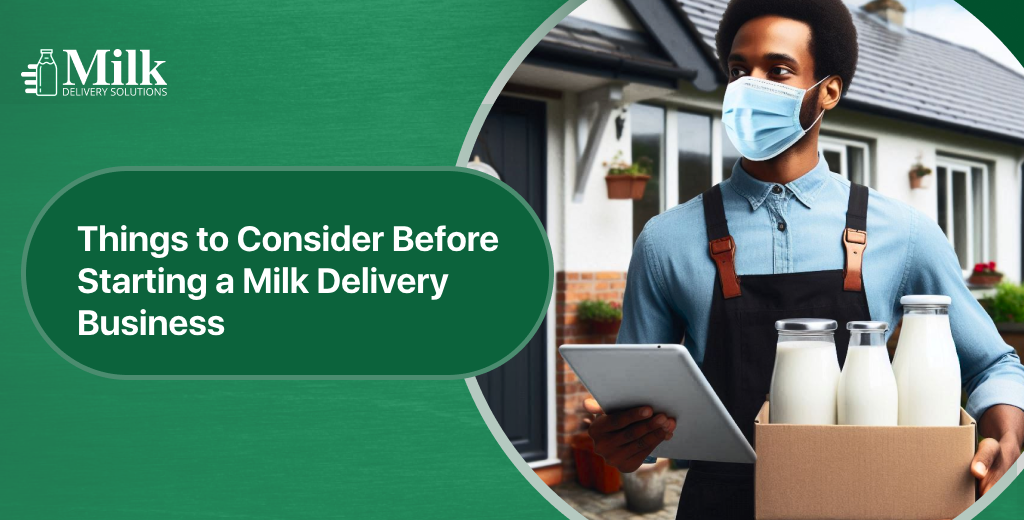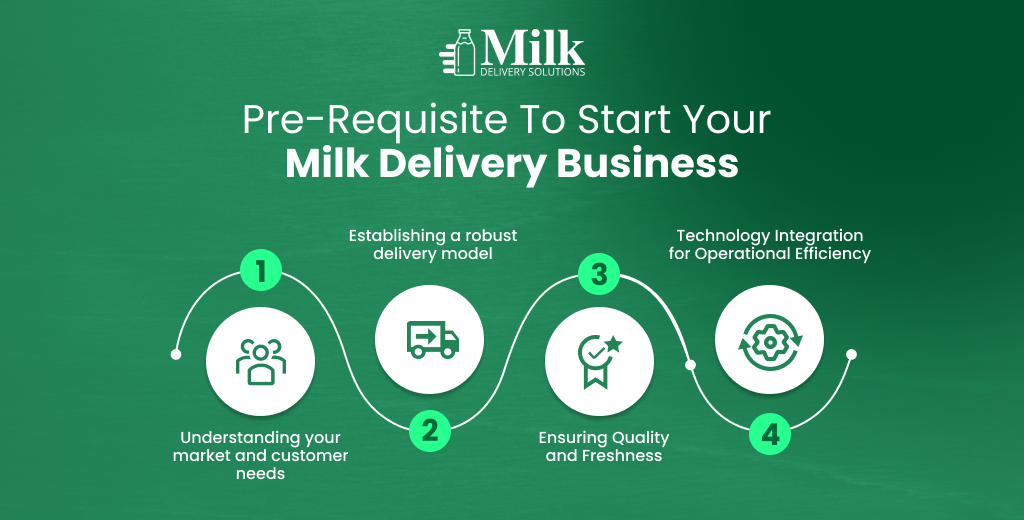Things to Consider Before Starting a Milk Delivery Business

The milk delivery business is a lucrative business idea, especially considering the expanding market for premium, fresh dairy products. However, getting into this field requires careful preparation and consideration of several crucial elements. Increasing the demand for convenience, integrating Milk Delivery Solutions (MDS) has become crucial to stay ahead in the market.
Essential things you need to know before starting your milk delivery business
1. Understanding your market and customer needs
Do a thorough market analysis to learn about local demand, consumer preferences, and rival businesses in your industry before starting a milk delivery service. Determine the target demographic’s preferences for milk types (organic, non-dairy alternatives, etc.), delivery frequency, and any additional dairy products they might need. This can involve identifying the target demographic, such as households, businesses, or niches.
2. Establishing a robust delivery model
Businesses that deliver milk frequently use a variety of models, each with special characteristics:
Traditional doorstep delivery – Daily or periodic deliveries directly to customers’ homes.
Subscription-based services – Offering subscription plans with milk subscription management software where customers pre-order and receive regular deliveries.
Retail or wholesale distribution – Selling to retailers, cafes, restaurants, or institutions in bulk quantities.
A delivery model that is in line with your target market and guarantees effective logistics should be selected, taking into account variables such as delivery routes, frequency, packaging, and scheduling.
3. Ensuring Quality and Freshness
In the dairy business, freshness and quality are crucial. For a steady and superior supply of milk and dairy products, form dependable alliances with nearby dairy farms or reliable vendors. To keep freshness intact during the delivery process, pay close attention to maintaining ideal storage and transportation conditions.
4. Technology Integration for Operational Efficiency
Make use of technology to improve customer satisfaction and expedite processes. Provide a user-friendly online or mobile application so that clients can track deliveries, manage subscriptions, and place orders. Use software for route optimization to create effective delivery routes and inventory control.
Milk Delivery Business Models
Direct-to-Consumer Model
This model entails regular doorstep delivery of milk and dairy products directly to consumers. In the direct-to-consumer milk delivery business model, customers subscribe to receive daily or periodic deliveries to their homes.
Features:
Subscription-based – Consumers choose their preferred milk type and quantity when subscribing to a delivery service for a predetermined time.
Convenience – Provides consumers convenience by delivering fresh milk to their doorstep, saving them from visiting stores.
Personalized service – Permits for customized orders and delivery schedules according to client preferences.
Advantages
Strengthens ties with clients, encourages loyalty, and offers convenience to clients who would rather have fresh milk delivered regularly.
Wholesale distribution
In this model, the milk delivery company provides dairy products and milk in large quantities at wholesale prices to institutions, restaurants, grocery stores, cafes, and retail stores.
Features:
Bulk sales – Sells dairy products and milk in bulk to stores or companies at a discount.
B2B transactions – Focuses on companies for bulk purchases.
Variety – Provides a variety of dairy products to meet the varying needs of its clientele.
Advantages:
Allows extensive distribution, forms alliances with other companies, and expands the customer base via physical stores.
Hybrid Models
To meet the needs of diverse customer segments or market demands, hybrid models incorporate components of multiple delivery methods.
Features:
Diversification – To diversify their revenue streams, businesses may combine wholesale distribution with subscription-based services or doorstep delivery.
Adaptability – Gives room for adaptability to shifting consumer preferences and market trends.
Targeted approach – Offers a variety of delivery options to cater to both businesses and individual customers.
Advantages:
Provides versatility, adaptability, and the capacity to target different customer segments simultaneously.
Subscription-based services
In this business model, customers can pre-order milk and dairy products for regular delivery through subscription plans.
Features:
Customized plans – Consumers select from a range of subscription packages according to how often and how much milk they need.
Predictable revenue – Gives the company a steady income stream from recurring subscriptions.
Flexibility – Enables users to change or cancel subscriptions based on their evolving needs.
Advantages:
Maintains a consistent clientele, improves client retention, and streamlines logistics and inventory planning.
How are daily milk deliveries made?
Modern daily milk deliveries are done using technologies like milk delivery software solutions. They help you streamline and optimize your milk delivery processes, improving business efficiency, productivity, and profitability.
Order Management and Customer Interaction
Order placement – Customers can order through various channels, including the company’s phone number, website, mobile app, or subscription-based services.
Subscription management – Oversee and manage repeat orders, ability to personalize, plan, suspend, or cancel orders according to their preferences.
Customer support – To properly handle consumer requests, complaints, feedback, and questions, keep lines of communication open.
Stock Control and Storage
Stock management – Effective stock management is crucial to guarantee a sufficient supply of dairy products while reducing waste, and keeping an eye on stock levels.
Storage conditions – Maintain appropriate storage conditions (temperature, hygiene, etc.) to preserve the freshness and quality of dairy items.
Route Planning and Logistics
Route Optimisation – Using technology for route optimization and multi-stop route planning increases productivity, reduces travel time, and plans delivery routes.
Scheduling – Consider customer preferences, subscription frequency, and geographic locations when planning and scheduling delivery routes.
Packaging and Preparation
Packaging – Milk and dairy products should be packaged properly to preserve freshness, stop spoiling, and maintain hygienic conditions while in transit.
Order assignment and dispatch – Orders should be assembled precisely, considering account customer preferences, subscription plans, and delivery dates.
Delivery Execution
Delivery Personnel – To complete planned deliveries, dispatch delivery staff who have received training and are outfitted with delivery vehicles.
Timely Deliveries – Delivering on defined schedules ensures dependability and timeliness.
Contactless Delivery – Provides contactless delivery choices for added convenience and safety, particularly in this age.
Technology Integration and Data Management
Technological tools – Using a milk dairy delivery management system for order processing, route planning, and customer management is important to improve business productivity.
Data analysis – Examine delivery data to improve efficiency, customer satisfaction, and route optimization.
Marketing and Expansion Strategies
Marketing efforts – Use marketing techniques like loyalty programs, promotions, and social media interaction to attract and retain customers.
Expansion opportunities – Examine potential avenues for growth, such as introducing new goods, branching out into untapped markets, or experimenting with different delivery strategies.
In summary, comprehensive market research, effective delivery strategies, high-quality products, technological integration, and regulatory compliance are critical to the success of a milk delivery company. You can create a solid foundation for your milk delivery business by taking care of these crucial issues with milk delivery app development and choosing a suitable business plan.
Contact us to see how Milk Delivery Solutions can help your business.



